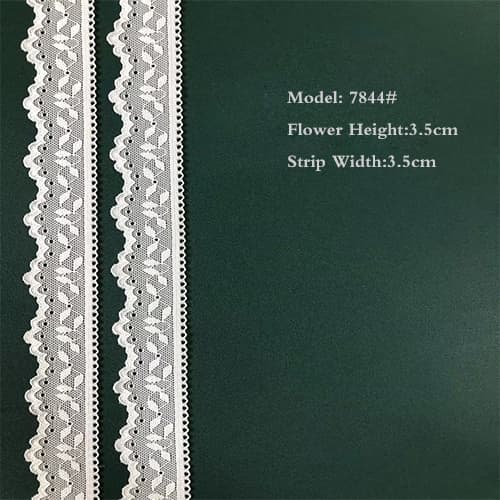
Whether for everyday wear or special occasions, the application of Stretch Lace can add sophistication, comfort and fashion features to garments. Its unique elasticity and the decorative nature of the Lace Band make the garment more attractive and bring a pleasant wearing experience to the wearer. lace fabric is often used to make evening dresses, banquet wear and formal occasion clothing. It imparts delicate texture and a feminine look to garments while providing comfort and elegance. Stretch lace fabric is also widely used in swimwear due to its good stretchability and water resistance. It adapts to the movement of the body, providing a comfortable fit and showing off a stylish swimwear design.
Product Ingredients:
Flower Height: 3.5cm
Strip Width:3.5cm
Product Display

When it comes to choosing fabrics that are environmentally friendly, several factors must be considered, including water usage, carbon footprint, biodegradability, and chemical treatment. Here are four to six of the best fabrics for the environment, backed by data:
1. Organic Cotton
Organic cotton is grown without synthetic pesticides or fertilizers, reducing water pollution and soil degradation. According to the Textile Exchange, organic cotton uses 91% less water than conventional cotton and emits 46% less CO₂. Additionally, it promotes biodiversity by avoiding genetically modified seeds.
2. Hemp
Hemp is a highly sustainable crop requiring minimal water and no pesticides. A study by the Stockholm Environment Institute found that hemp cultivation uses 50% less water than cotton and absorbs 15 tons of CO₂ per hectare. Its deep roots prevent soil erosion, making it a regenerative fabric.
3. Linen (Flax)
Linen, derived from flax plants, is biodegradable and requires fewer resources than cotton. Research from the European Flax Association shows flax cultivation uses 5 times less water than cotton and has a 60% lower carbon footprint. The entire plant is utilized, minimizing waste.
4. Tencel (Lyocell)
Tencel is made from sustainably sourced wood pulp using a closed-loop process that recycles 99% of solvents. The Lenzing Group reports that Tencel production consumes 10-20 times less water than cotton and generates 50% fewer emissions. It’s also fully biodegradable under industrial conditions.
5. Recycled Polyester
Recycled polyester (rPET) reduces plastic waste by repurposing PET bottles. The Higg Index reveals rPET cuts 75% of CO₂ emissions compared to virgin polyester and saves 90% of water. However, microplastic shedding remains a concern, requiring washing filters.
6. Wool (Ethically Sourced)
Natural wool is renewable and biodegradable, with a lower environmental impact when sourced responsibly. The International Wool Textile Organisation states that wool garments last longer, reducing waste, and sheep grazing can sequester 50 kg of CO₂ per hectare annually. Look for certifications like ZQ Merino for ethical standards.
Choosing eco-friendly fabrics is essential for reducing the environmental impact of textiles. Here are the best sustainable fabrics for key industries:
Organic Cotton and Hemp are top choices for clothing due to their low water usage and biodegradability. Tencel (Lyocell), made from sustainably sourced wood pulp, offers a soft, durable alternative to synthetic fabrics.
Linen, derived from flax, requires minimal pesticides and water. Recycled Polyester (from plastic bottles) is ideal for rugs and upholstery, reducing landfill waste.
Bamboo Fabric is naturally antibacterial and moisture-wicking, perfect for masks and bandages. Organic Wool provides breathable, chemical-free insulation for medical blankets.
Piñatex (pineapple leaf fiber) and Mushroom Leather offer cruelty-free, biodegradable alternatives for car interiors and seating.
Jute and Recycled Cotton are sturdy, compostable materials for tote bags and product packaging, replacing single-use plastics.
Recycled Nylon (from fishing nets) and Merino Wool provide durable, sweat-wicking performance with a lower carbon footprint.